Vehicle Connectedness and the First Connected Car
Daniel S. Fowler, Secure Cyber Systems Research Group, WMG, University of Warwick, Coventry, CV4 7AL, UK
dan.fowler@warwick.ac.uk
Abstract
The 21st century has seen the emergence of highly computerised vehicles. This has led to using the term connected car to label vehicles that use remote web-based services, interface with cell phone applications, and communicate with roadside systems; a prelude to fully autonomous vehicles. Here it is argued that whilst the term connected car is new, the underlying concept has existed almost as long as wireless communications. A discussion provides for the abstraction of connectivity from the specific technology. This abstraction is considered a useful definition of vehicle connectivity and provides the normally implied link to graph theory and associated routing protocols. As an aside, having defined the concept of vehicle connectivity it can be used to determine the world's first example of a connected car, and an argument is provided for that to be a 1920s Melbourne (Australia) police car.
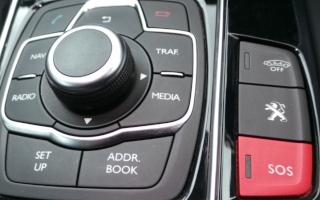
Figure 1. Emergency assistance, navigation and cellphone integration are examples of connected car features (author's image).
Introduction
A connected car has a wireless interface which allows it to communicate with other devices and locations to enhance its functionality [1], see Figure 1. Connected car technology is regarded as a growth area in the UK. The UK Government has established the Centre for Connected and Autonomous Vehicles (CCAV) to fund research and encourage investment [2]. The Society of Motor Manufacturers and Traders (SMMT) believe connected and autonomous vehicles (CAV) will lead the market by 2025 [3]. Manufacturers use the features of connected car technology to enhance their product offerings [4]. Despite the apparent rapid rise in connected car technology, this research shows that the concept is not a recent idea. Examining the underlying principle of the connected car it is demonstrated that the idea of vehicle connectedness has been around almost as long as wireless communications.
Overview
This research firstly examines how vehicles have become highly computerised, including the emergence of wireless connectivity. It is seen that the term connected car was then applied to a late 1990s product [1] by the Intel Corporation. This leads to examining the principles of connectivity, the relation to Shannon's communication model [5], and the link to graph theory. A list of services that a connected car can use is provided. The discussion finishes with a historical look at a candidate for the world's first connected car before concluding.
The computerised vehicle
The last quarter of the 20th century saw a rapid increase in vehicles fitted with firstly electronic and then computational systems. The addition of microprocessor systems to vehicles was initially spurred on by the Clean Air Act in the United States [6]. Manufacturers fitted computers, called Engine Control Units (ECUs), to vehicles to improve fuel efficiency and meet the requirements of the new pollution regulations.
The first decade of the 21st century saw computers deployed elsewhere in the vehicle to simplify wiring and add enhanced functionality. The meaning of ECU changed, becoming the Electronic Control Unit, also known as the On-Board Unit (OBU). In most categories of vehicles (except for motorcycles) multiple ECUs have become commonplace. As an example a mid-range executive car can have 30 to 40 ECUs [7], and these ECUs cover the entire range of vehicle functions, e.g., engine, braking, powertrain, lights, doors, instrumentation, and infotainment.
Furthermore, vehicles are no longer an isolated machine. The vehicle and the devices a passenger can carry (e.g., a cell phone, tablet or laptop computer) have wireless connections to multiple remote information exchange services. When a vehicle manufacturer adds wireless connectivity to a car it is marketed as a value-added feature [4]. This wireless connectivity feature is possible through the use of high-speed data (3G/4G/5G) services provided by telecommunications companies.
Computerisation and connectivity have moved the road vehicle into the arena of Cyber-Physical Systems (CPS). Cars, previously entirely dependent upon driver actions, now require electronics, sensors, computers, and software for operation, and they link outwards to other systems.
An early Internet-connected car
The concept of the connected car with a wireless link to Internet services was demonstrated by Intel in 1997 at Internationale Automobile Ausstellung (IAA) in Frankfurt, the German international motor show, see Figure 2. An example of the then-new Citroën Xsara production car was equipped with Intel's Connected Car PC technology [1].
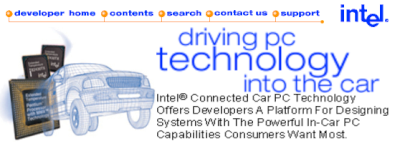
Figure 2: Intel’s early Connected Car PC offering [1], image used with permission.
The press releases describe the system's aims: "On request, the Connected Car PC picks up the travelers' incoming e-mail and, using a text to speech converter, reads it to them. Up to date information on weather, traffic and tourism can also be downloaded on demand by the Connected Car PC from the Internet." (sic)
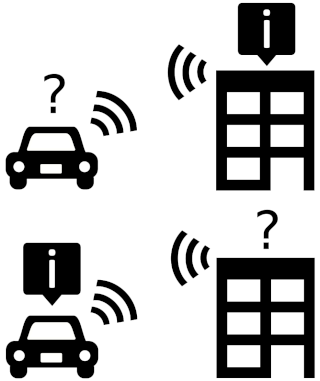
Figure 3: A connected car exchanges data with remote information sources (author's image).
What is vehicle connectivity?
Was the Citroën Xsara the first connected car? To answer that question an examination of what a connected car means is required. In essence, a connected car requires information from or provides information to, a different location, usually a remote location, see Figure 3. An exchange of data is required for the provision of information services. For Intel's concept that was email, weather reports, etc. The use of Global Positioning System (GPS) coordinates for location-based services (routing maps, nearest fuel stop, etc.) is another use. Table 1 lists other services that are relevant to connected cars.
Table 1: List of connected vehicle services.
| Description of Service |
|---|
| Crash detection and response |
| Route guidance (navigation, traffic reports and avoidance, local facilities) |
| Weather reports |
| Breakdown assistance |
| Vehicle diagnostics |
| Stolen vehicle tracking and recovery |
| Personal safety alerts |
| Internet connectivity (WiFi hotspot) |
| Safer driving guidance (behavioural footprinting, insurance telematics) |
| Fleet monitoring (fleet management telematics services, efficient logistics routing) |
| Vehicle-to-infrastructure (V2I) information and safety notices |
| Vehicle-to-vehicle (V2V) sensing |
| Vehicle apps, vehicle to device (V2D) connectivity |
| Vehicle functionality via smartphone apps (e.g., vehicle locate, vehicle lock/unlock, vehicle preheat, vehicle health) |
The transmission of information from the vehicle to a remote destination (or from the remote location to the vehicle) uses Shannon's general communication system [5] as shown in Figure 4. Wireless technology in the connected car has eliminated the physical tethering previously required to exchange information. Now wireless technology provides a virtual connection for the provision of services to vehicles and their occupants. This virtual connection is represented by Shannon's schematic. For the connected car the noise source consists of the electromagnetic interference from the vehicle's electrical systems, other environmental and buildings electromagnetic sources, and shielding effects from the vehicle body and environment. Circuit design, transmission protocols and signal strength are used to reduce or eliminate the effects of the noise.
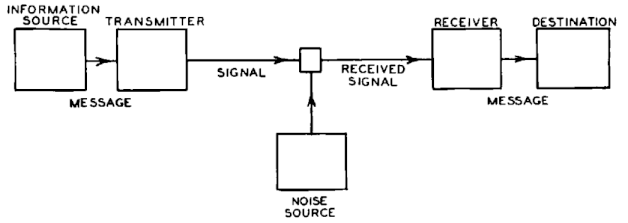
Figure 4: Shannon’s general communication system (original Bell System Technical Journal schematic) [5]
When noise is not affecting the signal the connected car is simplified as a directed graph (digraph), Figure 5. Each direction of communication is an example of Shannon's communication system.
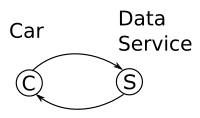
Figure 5: The data connection from a vehicle to a remote location can be considered as a digraph (author's image).
As vehicular systems continue to increase in functionality the car connections multiply to cover vehicle-to-vehicle (V2V), vehicle-to-infrastructure (V2I) and vehicle-to-device (V2D) applications, collectively V2X. V2V and V2I are an essential feature of Intelligent Transportation Systems (ITS) [9], see Figure 6. As the vehicles on the road age, they will be replaced with new models with connected and autonomous features. SMMT estimates that by 2025 all cars sold will be connected vehicles and the connected cars on the road will outnumber unconnected vehicles [3]. The advantages of V2V safety systems are regarded as particularly beneficial [8] (the potential to decrease vehicle accident rates and the attendant issues of loss of life, serious injury, impact on emergency services, infrastructure repairs, traffic flows and insurance costs).
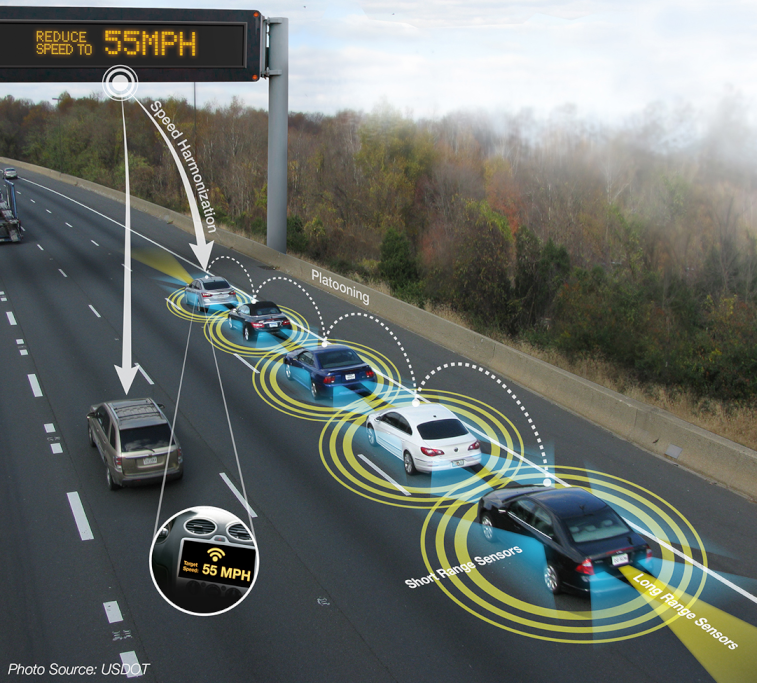
Figure 6: V2V connectivity is considered a means of reducing accident rates [8] (image from the U.S. Department of Transportation).
The simple digraph for a connected car can be expanded and used to represent multiple connected vehicles. Figure 7 is a small graph to illustrate the representation of connected vehicles as a graph. Vehicles may be isolated, or connected to V2V, V2I, or V2X. Representing the connectivity of a large traffic flow would produce very large graphs; however, they are not intended just for visualisations of networks. Large-scale graphs can be processed by software, as in the case of routing protocols [8,10]. The representation of vehicle connections in graphs allows for the use of connectedness in the mathematical sense. A graph is called connected if it is non-empty and any two of the vertices are linked by a path [11].
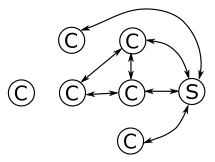
Figure 7: A car (C) can sense other vehicles and use remote information services (S) or be isolated (author's image).
Growth of early vehicle connectivity
When Intel announced their Connected Car concept General Motors (GM) had already developed their OnStar system, designed to provide roadside assistance, safety and security services [12]. GM initiated Project Beacon in 1994 to integrate services based on wireless communications into vehicles [13]. This was done by combining GM's vehicle manufacturing with technology from two GM subsidiaries, satellite communications from Hughes Electronics and data processing from Electronic Data Services (EDS). Ford announced the Remote Emergency Satellite Cellular Unit (RESCU) in late 1995 for its 1996 premium model Lincoln car to provide security and rescue services [14]. GM's OnStar launched in 1996 as a premium service for its luxury vehicles. It grew from 1100 subscribers in 1997, to 2.5 million in 2003 and 7 million in 2015.
Connected vehicle services
A connected car allows for the provision of value-added services to a vehicle driver and the passengers (Table 1). Any such service is based on the exchange of information between the vehicle and the remotely located service provider. The information exchange is in the form of digitally encoded data (e.g., vehicle location via GPS, vehicle identification, vehicle speed). The use of vehicle connectivity is not limited to private cars. The efficient delivery of goods and maximising resources is a concern for the logistics industry [15]. In this case, data from and to connected vehicles is used by algorithms in fleet management systems to maximise resources (time and material) and minimise costs.
The original connected cars
Verbal communication is still the primary form of human communication ahead of data exchange over digital data services. This was the case with the early GM OnStar using call centres for verbal exchanges. The long-distance verbal exchange of information over wireless connections has existed for well over 100 years. Wireless communication began with its invention towards the end of the 19th century. The initial deployment of wireless telegraphy was for ship communication at the beginning of the 20th century. Development continued during the First World War [17], helping to alleviate the problems with communications due to damage to wired telegraph lines from shelling. All the knowledge and experience of wireless communications developed during the First World War were soon used in civilian life as radio broadcasts rapidly expanded in the 1920s.
The use of radio beyond entertainment and being able to provide a useful service was soon envisaged. The Detroit Police Force began experiments with radio for police cars in 1921, though it would take until 1928 for them to become successful [18]. The press reported wireless communication interest by other police departments. This includes successful wireless communication tests by New York police communicating with harbour patrols [19], and the Chicago [20] and Paris [21] police interested in the new wireless technology. In January 1922 The Autocar publication reported on a wireless experiment on a Dodge car by a Mr. Dallin in America [22].
The initial use of radio by police forces was for them to broadcast dispatch messages on commercial radio stations [23, 18]. However, in 1922 The Argus newspaper of Melbourne (in Victoria, Australia) reported that the Melbourne police were conducting tests on wireless telephony [16]. Before the wirelessly equipped cars, the Melbourne police had deployed a mobile patrol car in response to the increasing crime rate. The patrol had to stop and use a normal telephone at regular intervals to communicate with the station. This often caused a time delay in responding to reported crimes. Police officer F.W.Downie, a member of the mobile patrol, thought radio would improve communication, inspired by often driving past a commercial transmitter. His Chief Commissioner responded to the idea by getting a car fitted with a radio [24] and the Police Wireless Section began. The first experiments were on a worn Hotchkiss car and then two new Lancia vehicles.
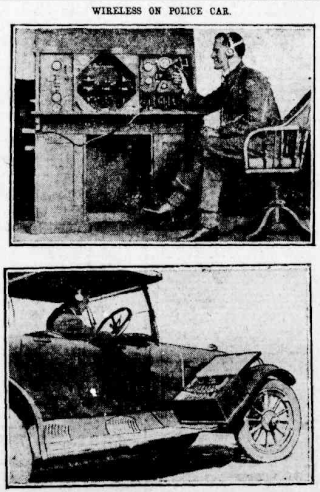
Figure 8: Melbourne police began testing car-based wireless telephony in 1922 [17] (public domain).
By May 1923 The Argus reported the wireless test as successful. There were arrests and prevention of burglary, achieved by being able to send patrol cars data on the locations of criminal activity [25]. Figure 9 shows the form used by the operators of the patrols, it can be seen that location, time, and identity were important data items, just as they are with the current connected cars.
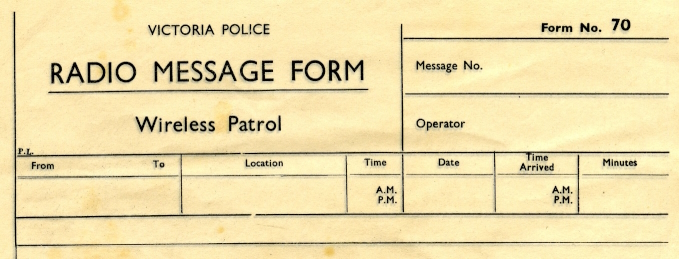
Figure 9: The data used for the Melbourne Police’s Wireless Patrol was captured on a paper form (courtesy of the Victoria Police Museum),
The wireless communication systems that began to be deployed to the police vehicles of the 1920s may not seem groundbreaking in our age of instant communication, however, this was the then-new technology. This technology was primitive but contained all the elements needed for vehicle connectedness. A 1920s Australian police car communicating with a remote location to obtain information provides a strong argument for the first connected car. Data is data whether it is coded verbally or digitally. From that point onwards vehicle connectivity, went from analogue to digital, to the Internet and the dawn of autonomous vehicles in less than 100 years.
Concluding
Despite vehicle manufacturers' marketing their products as being connected it has been shown that the idea is not new. Digitally connected vehicles emerged as the popularity of the Internet spread, with Intel announcing an early product to digitally connect vehicles to the Internet. However, analogue and verbal connected services were already being established, these new services were applications of the then-established analogue wireless cell phone networks. This mimicked the early household connections to the Internet that used dial-up modems. The connectedness of early services, such as GM's OnStar, was using the underlying communications principles that had been long established. It was shown that the wireless exchange of information with vehicles, the basis of any connected car service, was in use as far back as the 1920s. With this research, background knowledge has been provided to help understand the origination of the connected car. The research has provided a link to graph theory, an important subject for the analysis of connectedness. This background information will be useful for new researchers studying in the areas of ITS, CAV and CPS.
References
[1] Intel Corporation. Intel Connected Car PC Technology Demonstrated At World’s Largest Automotive Show, 1997. URL https://www.intel.com/pressroom/archive/releases/1997/IC090997.HTM.
[2] GOV.UK. Driverless vehicles: connected and autonomous technologies, 2016. URL https://goo.gl/VfjPh3.
[3] KPMG. Connected and Autonomous Vehicles - the UK Economic Opportunity. Technical report, SMMT, London, 2015. URL https://www.smmt.co.uk/reports/connected-vehicles/.
[4] General Motors UK. New Astra 2016 Model Edition 2, 2016. URL https://www.vauxhall.co.uk/bypass/download/gb/new_astra-brochure.pdf.
[5] Claude E Shannon. A mathematical theory of communication. The Bell System Technical Journal, 27(July 1948):379–423, 1948. ISSN 0005-8580. doi: 10.1002/j.1538-7305.1948.tb01338.x.
[6] EPA. The Clean Air Act in a Nutshell: How it Works. Technical report, EPA, Washington, D.C., 2013. https://www.epa.gov/sites/production/files/2015-05/documents/caa_nutshell.pdf.
[7] BMW. BMW Technical Training - F30 General Vehicle Electronics. Technical report, BMW Group, Munich, 2012.
[8] NHTSA. Vehicle-to-vehicle communications: Readiness of V2V technology for application. Technical report, National Highway Traffic Safety Administration, Washington, DC, 2014. URL https://rosap.ntl.bts.gov/view/dot/27999.
[9] F Li and Y Wang. Routing in vehicular ad hoc networks: A survey. IEEE Vehicular Technology Magazine, 2(2):12–22, Jun 2007. ISSN 1556-6072. doi: 10.1109/MVT.2007.912927.
[10] Baraa T. Sharef, Raed A. Alsaqour, and Mahamod Ismail. Vehicular communication ad hoc routing protocols: A survey. Journal of Network and Computer Applications, 40:363 – 396, 2014. ISSN 1084-8045. doi: 10.1016/j.jnca.2013.09.008.
[11] Reinhard Diestel. Graph Theory. Springer-Verlag, Heidelberg, 5th edition, 2016. ISBN 9783662536216. https://diestel-graph-theory.com/index.html.
[12] Roger Allan. OnStar System Puts Telematics On The Map. Electronic Design, page n/a, Mar 2003. https://web.archive.org/web/20160811164636/http://media.gm.com/media/us/en/gm/home.detail.html/content/Pages/news/us/en/2015/jul/0729_onstar.html.
[13] Stefan Cross. OnStar Tops 1 Billion Customer Interactions, 2015. URL https://web.archive.org/web/20160811164636/http://media.gm.com/media/us/en/gm/home.detail.html/content/Pages/news/us/en/2015/jul/0729_onstar.html.
[14] Ralph Kisiel. Lincoln Rescue Device Can Call a Tow Truck. Automotive News, page n/a, Aug 1995. URL https://www.autonews.com/article/19950821/ANA/508210769/lincoln-rescue-device-can-call-a-tow-truck.
[15] Andrea Attanasio, Jay Bregman, Gianpaolo Ghiani, and Emanuele Manni. Real-Time Fleet Management At Ecourier Ltd. In Vasileios Zeimpekis, Christos D. Tarantilis, George M. Giaglis, and Ioannis Minis, editors, Dynamic Fleet Management, pages 219–238. Springer US, New York, 2007. ISBN 9780387717210. doi: 10.1007/978-0-387-71722-7_10.
[16] Argus. Wireless on Police Car, Nov 1922. URL http://trove.nla.gov.au/newspaper/article/1852252.
[17] Peter R. Jensen. Wireless at War : Developments in Military and Clandestine Radio, 1895-2012. Rosenberg Publishing, Kenthurst, 2013. ISBN 9781922013477.
[18] Joseph A. Poli. Development and Present Trend of Police Radio Communications. Journal of Criminal Law and Criminology, 33(2):193–197, 1942. URL https://scholarlycommons.law.northwestern.edu/cgi/viewcontent.cgi?article=3140&context=jclc.
[19] Geelong. Calling for Police by Wireless, Feb 1921. URL https://trove.nla.gov.au/newspaper/article/165756075.
[20] Argus. Police and Wireless American Experiments, Oct 1922. URL https://trove.nla.gov.au/newspaper/article/1851685.
[21] Times. Paris Police Use Wireless, Mar 1922. URL https://trove.nla.gov.au/newspaper/article/222624420.
[22] Autocar. Wireless Equipment, Jan 1922.
[23] Coe Lewis. Wireless Radio: A Brief History. Mcfarland & Co Inc, Jefferson, 1996. ISBN 9780786402595.
[24] Peter B. Wilson. The Crime Car Squad. Australian Security Journal, (February-March):24–26, 1971.
[25] Argus. Police Wireless More Cars to be Equipped, May 1923. URL https://trove.nla.gov.au/newspaper/article/2005318.
Additional Information
- There is a PDF version of this article available.
- See the list of all the Tek Eye articles in the Tek Eye website index.
Author:Daniel S. Fowler Published: Updated:







